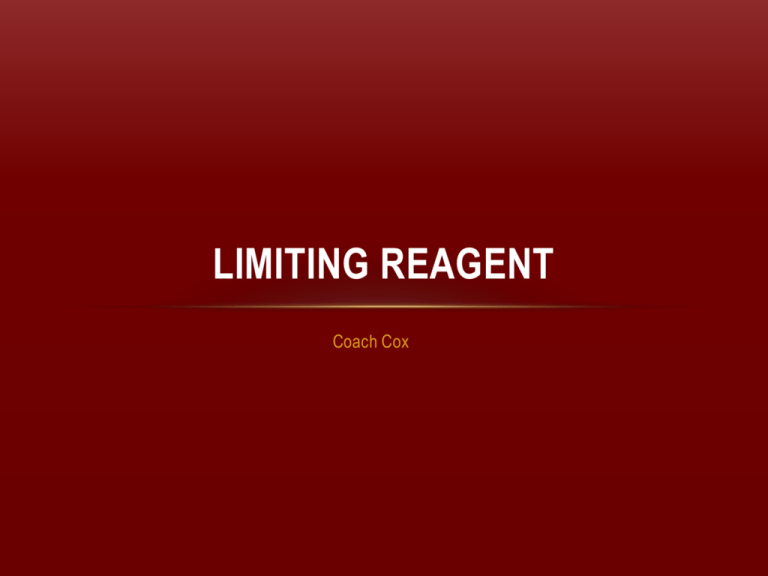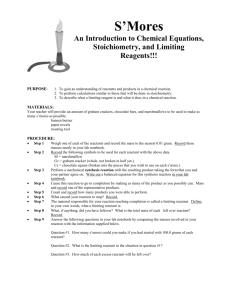Limiting Reagent (Reactant)
advertisement

LIMITING REAGENT Coach Cox WHAT IS A LIMITING REAGENT? • Limiting Reagent (Reactant) – the reactant in a chemical reaction that limits the amount of product that can be formed. The reaction will stop when all of the limiting reactant is consumed • Excess Reactant – the reactant in a chemical reaction that remains when a reaction stops when the limiting reactant is completely consumed. The excess reactant remains because there is nothing with which it can react. EXAMPLE • No matter how many tires there are, if there are only 8 car bodies, then only 8 cars can be made. Likewise with chemistry, if there is only a certain amount of one reactant available for a reaction, the reaction must stop when that reactant is consumed whether or not the other reactant has been used up. EXAMPLE LIMITING REAGENT CALCULATION A 2.00 g sample of ammonia is mixed with 4.00 g of oxygen. Which is the limiting reactant and how much excess reactant remains after the reaction has stopped? First, we need to create a balanced equation for the reaction: ___ NH3(g) + ___ O2(g) ___ NO(g) + ___ H2O(g) EXAMPLE LIMITING REAGENT CALCULATION • Next we can use stoichiometry to calculate how much product is produced by each reactant. • NOTE: It does not matter which product is chosen, but the same product must be used for both reactants so that the amounts can be compared. EXAMPLE LIMITING REAGENT CALCULATION • Balanced Equation: 4 NH3(g) + 5 O2(g) 4 NO(g) + 6 H2O(g) • Given in | Convert to | Mole to | Convert to Question | Moles (MM) | Mole Ratio | grams (MM) 2.00g NH3 | 1 mol NH3 | 4 mol NO | 30.0 g NO = 3.53 g NO (excess - EX) | 17.0 g NH3 | 4 mol NH3 | 1 mol NO • 4.00 g O2 | 1 mol O2 | 4 mol NO | 30.0 g NO | 32.0 g O2 | 5 mol O2 | 1 mol NO = 3.00 g NO (limiting - LR) EXAMPLE: LIMITING REAGENT CALCULATION ANSWER • The reactant that produces the least amount of product in this case is the oxygen, which is the "limiting reactant." EXAMPLE: LIMITING REAGENT CALCULATION ANSWER • Next, to find the amount of excess reactant, we must calculate how much of the non-limiting reactant (ammonia) actually did react with the limiting reactant (oxygen). • • 4.00 g O 2 | 1 mol O2 | 4 mol NH3 | 17.0 g NH 3 | 32.0 g O 2 | 5 mol O2 | 1 mol NH3 = 1.70 g NH3 EXAMPLE: LIMITING REAGENT CALCULATION ANSWER • We're not finished yet though. 1.70 g is the amount of ammonia that reacted, not what is left over. To find the amount of excess reactant remaining, subtract the amount that reacted from the amount in the original sample. • 2.00 g NH3 (original sample) – 1.70 g (reacted) = 0.30 g NH3 remaining






